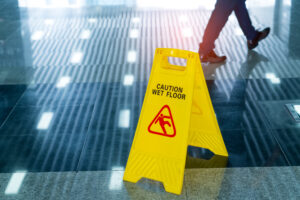California Comparative Negligence Law
When a person owes another a duty of care through action or decision, and the person fails to do that, it is considered negligence. For instance, if a person approaches a stop sign at an intersection, the person has a duty of care to other drivers and pedestrians to stop. Failing to stop and causing an accident is negligence on the driver’s part. To provide another example, a store owner has a duty of care to make sure that entryways are dry or safe when it rains. If the store owner does not clean up water that people track into the entryway and does not take steps to minimize falls, that is negligence. In cases involving personal injury, negligence contributes or leads to someone being harmed.
In all states, laws exist to discourage carelessness and to protect people who are victims of others’ negligence. While definitions of negligence are consistent throughout other states, the degrees of defined fault and how damages are compensated may differ. California uses a form of comparative negligence, which looks at the degree or percentage of fault that an individual has in a specific incident. Any financial awards for damages are based on percentage of responsibility. However, some states that use the contributory negligence doctrine do not allow people to collect compensation for a personal injury if they are even a tiny bit responsible for causing it.
How Does California’s Pure Comparative Negligence Law Work?
In cases of negligence, fault refers to blame. It may lie with one or more involved parties in a personal injury incident. California rules divide blame based on specific factors by percentages, and each party is responsible for the percentage of the blame. For instance, imagine that two people are in a car accident. One driver is 75% to blame, and the other driver has a 25% share of the fault. The driver with the larger percentage of blame would be responsible for 75% of the damages for the accident, and the other driver would be responsible for 25%.
Because of the “pure” comparative negligence doctrine of California for injury cases, even people who are 99% to blame for an accident may be able to recover at least some damages. In other states that have “modified” comparative doctrines, people can only recover damages if their share of the blame is under 50%. In California, when any plaintiffs attempt to collect damages, their awards are reduced by their percentage of responsibility for the accident. For instance, if the damage award is $10,000, and a plaintiff’s share of the blame is 25%, the award would be reduced by $2,500 to be a total of $7,500.
How Is Comparative Fault Determined?
With injury cases in California, a judge or a jury determines the share of blame for injuries. How percentages are divided and formulated may also depend on the complexity of the case and how many contributing factors exist. For example, a case with two drivers in an accident where both are distracted may not be as complex as an accident where four drivers are involved, there is inclement weather and all of the drivers are distracted.
Whether a jury or a judge determines responsibility depends on the case going to trial or being settled out of court. Many cases involving personal injuries are settled out of court. When there is a trial, the jurors receive instructions that educate them about California’s applicable laws. In cases where negligence is shared, the instructions state that the defendant must prove the plaintiff’s negligence and that the negligence was substantial in causing harm. If the jury can verify the relevant claims, they must determine responsibility percentages for the plaintiff and defendant. Whether there are two or more parties involved, the percentages assigned to each party must total 100 when they are added together. After that, the jury determines the extent of damages to formulate a damage total for the accident.
What Types of Cases May Involve Comparative Negligence?
The most common types of cases that apply to this area of California law are accidents. These are some examples:
- Truck accidents
- Bus accidents
- Bicycle accidents
- Motorcycle accidents
- Car accidents
- Medical malpractice accidents
- Slip and fall accidents
Although those are common types of claims where negligence is divided comparatively, there may be others. Our team will be happy to discuss any other types of accident cases.
Traffic Accidents
When it comes to accidents on roadways, there are many potential forms they can take. In cases where responsibility is often shared, these are some common types of accident cases:
- Uber or Lyft accidents
- Head-on collisions
- Rear-end collisions
- DUI accidents
- Road construction site accidents
- Multi-vehicle accidents
When multiple vehicles are involved in an accident, there may be other contributing factors. For example, a driver may run a stop sign while two other cars are approaching an intersection if the stop sign is covered by overgrown shrubbery on city property. To provide another example, a driver may veer into another lane to avoid a road construction worker who is partially parked in a traffic lane when he should not be, and the driver may sideswipe another car. If that car stops suddenly, the car behind it may crash as well. Attorneys investigate accidents carefully to determine all involved parties and responsibility factors.
Premises Liability
Property owners have a duty to do the following:
- Inspect the property
- Conduct necessary maintenance
- Fix potential dangers
- Warn of potential dangers
A common example of warning about potential dangers is putting up a “wet floor” sign when a floor is being cleaned. Also, a store owner may put up signs in a bathroom to remind people not to set their children on hanging countertops that may not be sturdy enough to hold them. People who are injured in premises liability accidents may be able to collect damages. However, as it is with auto accidents, damages are reduced by the share of negligence.
Medical Malpractice
Doctors must carry malpractice insurance to cover potential lawsuits. In California, some medical malpractice lawsuits may reveal partial negligence of the patient and partial negligence of the physician. For instance, if a patient has a surgery, experiences complications and waits a long time to report them, the patient may be partially responsible and would have a reduced award based on his or her share of responsibility.
Joint and Several Liability: When More Than Two Parties Are Involved
If there are more than two defendants the plaintiff can pursue damages from, the plaintiff may recover from both or either of them. This rule is called joint and several liability. With California’s laws, joint and several liability includes property damages, medical costs, loss of earning ability, income loss and some non-economic damages.
This rule helps reduce the impact of collecting damages from everyone. For instance, the plaintiff may only go after one defendant. That defendant may try to sue the other defendant since that individual had to pay the plaintiff. If the plaintiff goes after both defendants, they may also try to sue each other.
How a Personal Injury Attorney Helps
With any type of accident or injury where there may be comparative negligence, it is important to work with an attorney who understands California’s applicable laws and has handled similar cases. Many people suffer extensive injuries, such as permanent brain injuries. Families of victims of medical malpractice, auto accidents or other forms of negligence can also recover damages for the wrongful death of a loved one.
An attorney can collect and carefully analyze details to find all related factors and help build a strong case in favor of the plaintiff. A personal injury attorney who works with a plaintiff collects payment after the plaintiff gets paid. Since private parties or insurers who represent other involved parties rarely offer fair amounts for injuries, it is important to work with an attorney to protect personal interests and future financial stability. We work hard for fair compensation for our clients. From scooter or pedestrian accidents to catastrophic injuries, we handle a wide array of injury cases. Please contact us to learn more.



